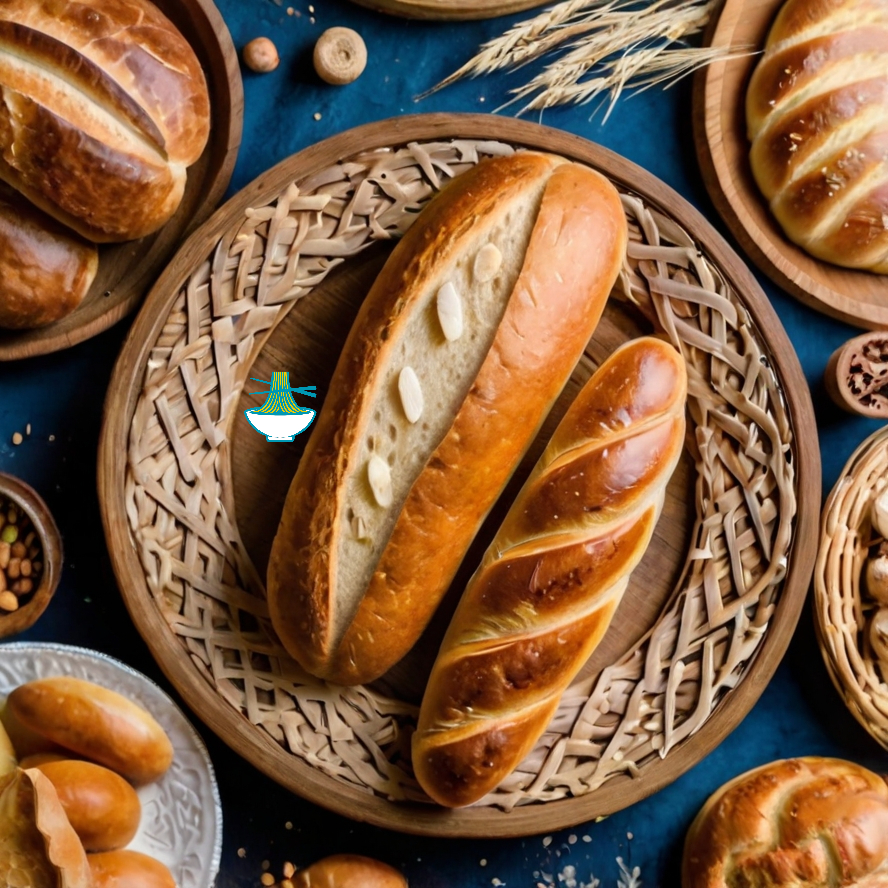Embark on a culinary journey through Kazakhstan's diverse bread culture. From traditional flatbreads to delightful bread rolls, Kazakh breads are a testament to the country's rich culinary heritage. Discover the unique flavors and textures that make Kazakh bread a beloved staple in the local cuisine.
Kazakhstan Bread Recipe:
Ingredients:
- 3 cups all-purpose flour
- 1 cup warm water
- 1 tablespoon active dry yeast
- 1 teaspoon sugar
- 1 teaspoon salt
- 1 tablespoon vegetable oil
Instructions:
1- In a small bowl, combine the warm water, sugar, and yeast. Let it sit for about 5-10 minutes, or until foamy.
2- In a large mixing bowl, combine the flour and salt. Make a well in the center and pour in the yeast mixture and vegetable oil.
3- Mix the ingredients until a dough forms. Knead the dough on a floured surface for about 5-10 minutes, or until smooth and elastic.
4- Place the dough in a greased bowl, cover with a clean towel, and let it rise in a warm place for about 1-2 hours, or until doubled in size.
5- Preheat your oven to 400°F (200°C). Punch down the dough and divide it into small portions for flatbreads or shape into rolls.
6- For flatbreads, roll out each portion into a thin circle. Place the flatbreads on a baking sheet lined with parchment paper and bake for about 5-7 minutes, or until lightly golden brown.
7- For bread rolls, shape each portion into a ball and place them on a baking sheet lined with parchment paper. Let them rise for an additional 15-20 minutes, then bake for about 15-20 minutes, or until golden brown.
8- Serve the Kazakhstan bread warm with butter, cheese, or your favorite spreads. Enjoy!
Nutritional Values:
Here are approximate nutritional values for the ingredients in the Kazakhstan Bread recipe per serving:
3 Cups All-Purpose Flour:
- Calories: 1,200 kcal
- Fat: 6 g
- Carbohydrates: 240 g
- Protein: 12 g
Benefits:
- Energy: Provides a significant amount of carbohydrates, which are a primary energy source.
- Versatility: Used as a base for various baked goods.
1 Cup Warm Water:
- Calories: 0 kcal
- Fat: 0 g
- Carbohydrates: 0 g
- Protein: 0 g
Benefits:Hydration: Essential for activating yeast and hydrating the dough.
1 Tablespoon Active Dry Yeast:
- Calories: 20 kcal
- Fat: 0 g
- Carbohydrates: 2 g
- Protein: 2 g
Benefits:
- Leavening Agent: Causes dough to rise and gives baked goods a light, airy texture.
- Nutritional Value: Provides some B vitamins and proteins.
1 Teaspoon Sugar:
- Calories: 16 kcal
- Fat: 0 g
- Carbohydrates: 4 g
- Protein: 0 g
Benefits:Yeast Activation: Provides a quick source of food for the yeast, helping it to activate and rise.
1 Teaspoon Salt:
- Calories: 0 kcal
- Fat: 0 g
- Carbohydrates: 0 g
- Protein: 0 g
Benefits:
- Flavor Enhancer: Improves the taste of the dough.
- Texture: Strengthens gluten structure and controls yeast activity.
1 Tablespoon Vegetable Oil:
- Calories: 120 kcal
- Fat: 14 g
- Carbohydrates: 0 g
- Protein: 0 g
Benefits:
- Texture: Helps to tenderize the dough and improve its consistency.
- Moisture: Adds moisture to the dough, preventing it from becoming too dry.
Please note that these values are approximate and can vary based on the specific brands and quantities of ingredients used.


Comments